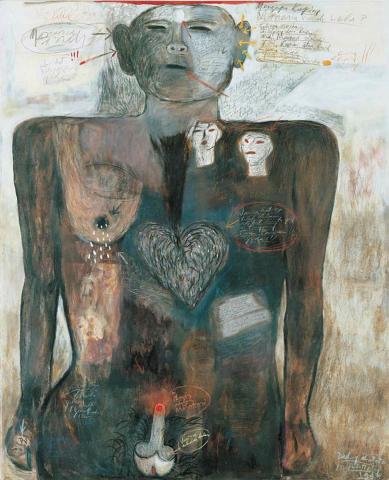ESSAY: Dadang Christanto's Manusia tanah (The earth human)
The work Manusia tanah (The earth human) was included in Dadang Christanto's solo exhibition in Yogyakarta in 1997. The show included a series of works of lone heads as well as a group of seven large paintings of which Manusia tanah was one example. His standing figures are emblems of the common man, who might be perceived as passive victim and active martyr. The 'Manusia tanah' in this painting is of an androgynous figure, half male and half female. The Hindu Ardhanareshvara, an aspect of Shiva which embodies both male and female characteristics, is alluded to in this painting. Like the Shiva aspect, which is the cosmic embodiment of creative power and destruction, this 'Manusia tanah' also has both characteristics.
However, it is the nature of the destructive aspect that sets this earth human apart, a dark (polluted), corrupted and disempowered figure. Instead of the third eye on his forehead an arrow points to a space. The text that relates to this decries a brain that lacks the potential for critical thought, is small and corrupt. The heart has been dulled by suffering and, encased within it, a germ of pain to be carried into the future. Yet this figure incorporates the symbols of human procreation and the symbolic milk of life which signals continuity and survival.
Christanto believes in non-violence but understands that violence is an endemic characteristic of human culture. In his installations, he explores notions of power and disempowerment, victimhood and the nature of violence. In his paintings from this period, the roles of the human enforcer and victim have collapsed. The seeds of violence/disempowerment, destruction/creation exists in parallel within a figure that is a symbol of universal humankind. Unlike the cosmic Shiva, this figure does not carry any of the glory or spiritual supremacy of a God. It is instead a foreboding and volatile figure.
